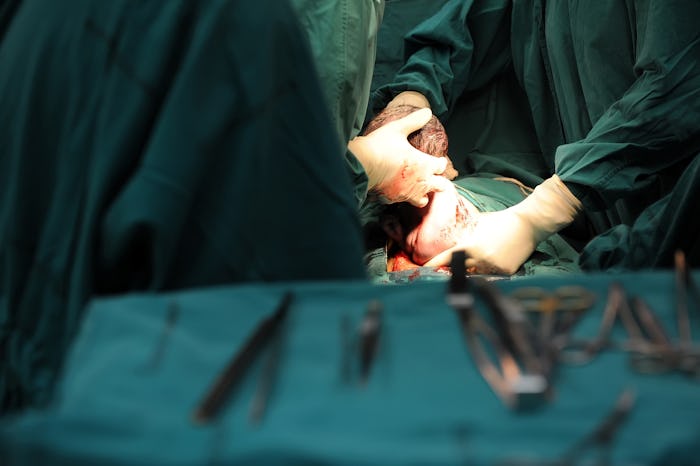Life

How To Know If You Should Have A C-Section, According To Experts
If you're anything like me, 40 weeks of pregnancy means spending 35 weeks wondering how that baby is going to make their way into the world. There are endless options for birth plans and birthing styles, but in the end, there are only two options for how the baby is coming out: a vaginal birth or a C-section. So how exactly will you know if you should have a C-section? Here are a few indications you might be headed that route.
If you have a C-section birth, that means your baby is "lifted out directly from your belly, rather than pushed out from your vagina," as explained by Parents. And if you have a C-section birth, that decision is either going to be made ahead of time by you and your doctor, or it's going to be made at the recommendation or insisting of your doctor after labor has already started and, for any number of reasons, a trip to the operating room becomes medically necessary.
If your doctor has scheduled you for a C-section rather than wait for you go to into labor, there could be a number of reasons for essentially planning ahead. If your baby is in the breech position, for example, you'll need to have a C-section because it's safer to deliver the baby that way. The American Pregnancy Association (APA) describes a baby in breech, saying:
Most babies will move into delivery position a few weeks prior to birth, with the head moving closer to the birth canal. When this fails to happen, the baby’s buttocks and/or feet will be positioned to be delivered first. This is referred to as “breech presentation.”
According to the APA, "breech births occur in approximately one out of every 25 full-term births."
If you have had a C-section before, it's possible for you to be able to deliver your baby vaginally, but you will always be offered the option to deliver your baby by C-section again. According to Parents, 80 percent of C-sections are repeats.
Once your labor has started, you might be faced with the recommendation or necessity of a C-section for a few different reasons. If you have placenta previa, which the Mayo Clinic defines as "when a baby's placenta partially or totally covers the mother's cervix — the outlet for the uterus," or placental abruption, which the APA defines as "the separation of the placenta from the uterine lining," you could be looking at a life-saving c-section for both you and baby. According to the APA, "one in 200 pregnant women will have placenta previa in the third trimester of pregnancy," and "only about one percent of all pregnant women will experience placental abruption, and most can be successfully treated depending on what type of separation occurs."
Lastly, if your baby is distressed, your doctor will change your birth plan from vaginal delivery to a C-section in order to ensure your baby's health is protected. According to Parents, the two most common reasons for a c-section are because your labor is stalling or your baby's head is too large to fit through your pelvis, accounting for about 30 percent of all C-sections. Likewise, you'll be headed for a C-section if there are issues with the baby’s heart rate or if the baby’s oxygen supply has been disrupted by a prolapsed cord.
If you're curious about how frequent C-sections are performed in the United States, it's a sort-of staggering 32 percent of births, according to the Center for Disease Control and Prevention (CDC). That rate is double the recommended rate suggested by the World Health Organization (WHO).
While C-sections aren't every part of every pregnant woman's birth plan, one thing is certain: they save lives. So if you do end up needing and/or choosing a C-section, know that they're common, safe, and usually result in the birth of a healthy, happy baby.
Watch Romper's new video series, Romper's Doula Diaries:
Check out the entire Romper's Doula Diaries series and other videos on Facebook and the Bustle app across Apple TV, Roku, and Amazon Fire TV.